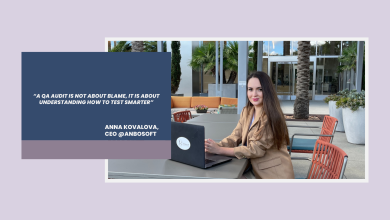Can you explain your role at Cognite and what its mission is?
My current role is head of our delivery organization: Strategic Customer Services. Our mission is to help our customers to get the most value out of our product suite. As Cognite is currently in a high growth phase, it´s really important for our department now to optimize for scale. For example, more and more we are identifying solutions that we build on top of our product suite that are potentially repeatable across multiple industries; hence, helping us customers with faster time to value.
What are the benefits of 5G technology?
5G is both faster and has higher capacity than previous generations of mobile technology. More importantly though is that 5G is the first software-defined network so, it has a lot more flexibility and you can program layers of intelligence on it. It is because of this flexibility that 5G will be capable of, for example, connecting billions of IoT devices. We already have millions of IoT devices connected and lots of M2M use cases, but, once we get into the billions, you need a network that is smart and flexible enough to handle that scale. Because 5G is software-defined, it is much more flexible, allowing operators to offer differentiated connectivity services. Network slices optimized either for QoS, Security, bandwidth or latency would be a good example. It is also easier to integrate other software with additional functions to the network and create many new services.
What investments can business leaders make now to take full advantage of 5G?
When it comes to the investments business leaders need to make now to take full advantage of 5G, I believe companies need to not just think about 5G, but the powerful trifecta of 5G, AI and IoT, combined with the power of DataOps. With these technologies all working in tandem, you have the foundation for infinite business and operational transformations. 5G gives you the low-latency, super-fast connectivity with the AI brain of the network. DataOps platforms then gather it all, contextualize it, make it useful to people. Investments in these technologies will give enormous impact in the consumer world, but importantly also in industry – particularly heavy asset and process industry where facilities that were built 30-40-50 years ago can now utilize all the data being generated in disparate silos of meters to modernize and become more efficient, safer and more sustainable. Industrial DataOps is an emerging field that dissects really complex dynamics and processes, and allows both workers and machines to make better, smarter, more data-driven decisions in real-time.
Of course, in today’s world, no one can go it alone to achieve these ambitious goals. Enterprises will also need to invest in partnerships with a wide array of companies involved: some of them offering components of these solutions while others offer end-to-end services on top of connectivity. These could include security, analytics and so on. We are already seeing a growing ecosystem of these types of companies.
Data is the backbone of many businesses today, what are the reasons that organizations may hesitate to adopt 5G?
One reason could be that business leaders don’t currently see services that require more functionality than their 4G connectivity. But this will change as the ecosystem grows and richer applications and services are launched around them which require 5G´s unique features. Also, in most developed regions today 5G coverage is still primarily in urban hotspots or in certain rural areas where the fixed wireless access use case is the main focus. So, a business wanting to utilize 5G in their facilities may have to invest in a 5G private network to get its capabilities. Many companies are currently evaluating what their return on investment would be for this deployment.
When do you predict 5G will be widely available?
According to GSMA Intelligence, 5G networks already cover over 20% of the world and this is set to double by the end of 2024. Coverage in some markets is already far beyond this with 5G adoption amongst the early tech adopters including South Korea and Switzerland already surpassing 90% and coverage in North America as a whole over 80%. It’s not just developed markets rapidly rolling out 5G. China now has half of its population covered by 5G whilst the mobile operator, AIS in Thailand recently reported over 40% population coverage. For some however, including most of Sub Saharan Africa and Latin America, it will take a while longer for 5G to reach the majority of the population
How will these new technologies help or hinder the world´s sustainability agenda?
The driving force of actual industrial innovation and solution development in this new 5G world will be an emerging technology category, which we refer to as Industrial DataOps. Industrial DataOps is a new discipline in industrial technology, using data to generate value, ensuring lineage, traceability, transparency and collaboration. This is one of the single most important vehicles for turning industrial data into tangible value and powering asset-heavy industries’ digital transformations.
There are many exciting use cases for Industrial DataOps, from production optimization to predictive maintenance, many of which have profound sustainability impact.
When it comes to sustainability, getting real-time data is a game-changer. Until now, most companies report sustainability metrics reactively. Real-time data enables a proactive approach, completely changing how companies will be able to address activities that have high environmental impact or are carbon-intensive. These emerging technologies together will allow industrial companies to measure and predict emissions and waste output in real-time allowing them to adjust production with the purpose to pollute less or mitigate emissions or other waste products before they are released into the environment.
With data this rich, we can build digital twins or digitally reconstructed realities of your industrial operations where you can track, monitor, even predict operational issues — all based on real time inputs. 3D Digital Twins can help to reduce emissions since the early set-up of the operations or can be used to plan greenfield plants. They can be used to analyze and simulate sustainability impact before we deploy processes or assets, taking in consideration sustainability from the design phase, enabling real-time testing, rapid prototyping, manufacturing process simulation and optimization. We can also use them to visualize the impact across the full value chain, such as across an industrial complex, and integrate both value and sustainability supply chain scenario planning into decision-making processes there.
In the end, we want to be part of building an industrial world where technology won’t just be for IT experts. All of the work mentioned is growing out of strong industrial data foundations that put the power of industrial technology into the hands of every worker.
The power of data, AI and Industrial DataOps in the hands of everyone in an industrial organization, gives them the best information, will help them tackle the toughest challenges, make the smartest decisions, and build an agile, future-ready organization. This is where we are headed.



